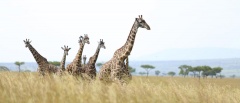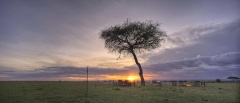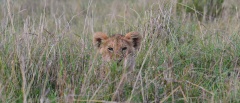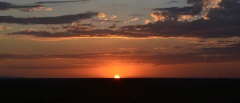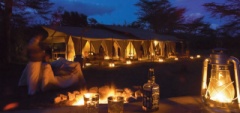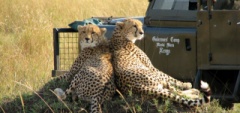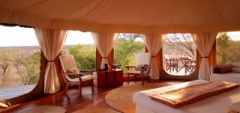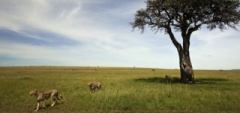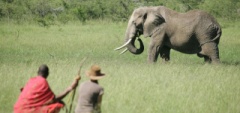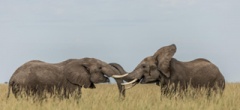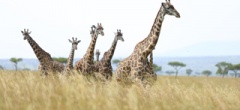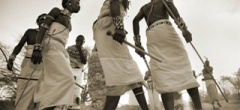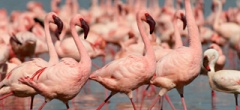The Masai Mara
Home to the richest concentration of wildlife in all of Kenya!
Spanning approximately 3,000 sq kms, the Masai Mara National Reserve and Greater Mara Concession Areas form the northern section of one of the most astounding animal migrations on the planet. While the region has become busier and busier over the last decade or so, a visit to this stunning area is still well worthwhile. Often seen as in its prime when the Migratory herds arrive, from July to November, a visit out of season can be just as rewarding, and the reason the BBC have based themselves here for the last decade or so.
The Masai Mara Reserve
The Masai Mara National Reserve is amongst the most famous of all of the 17 parks and reserves dedicated to wildlife in Kenya. At approximately 1,800 sq kilometres, it is not a vast tract of land but, due to the abundance of water year round, it is a haven to wildlife from all around and the home to the Great Migration that visits from late July to November. As a series of small catchment areas, the Masai Mara Reserve and conservation area (the Greater Mara), are fortunate to have their own eco-system and therefore have not been so affected by the droughts that have plagued East Africa over the years. One of the main factors in this, is also the flow of the Mara River up from Lake Victoria which cuts north from the border, providing a lifeline to the park. The reserve consists, primarily, of open grassland, with clusters of the distinctive acacia tree in the south-east region, and the Oloololo Escarpment that rises up along the western border, creating a funnel for the game as it arrives. This area to the west is the area where the wildlife tends to be most concentrated and, as the swampy ground means that access to water is always good, the tendency is for fly in safari staying in the smaller, more intimate camps and lodges. The easternmost border, approximately 224 kilometres from Nairobi, is far more accessible and so tends to suffer from the larger groups and mini-van trips and so will tend not to be on the agenda for those wishing a more private itinerary.
The Greater Masai Mara
Unlike the Mara National Reserve, the region that surrounds the reserve is owned by the local, Maasai communities and is, therefore, controlled and managed by them. Traditionally the nilotic, pastoralist people of the Masai have long worked these areas of land, but, as they have become aware of the potential revenues from tourism, they have slowly realised that the land would be better served for wildlife. With this in mind, what the Greater Mara offers that is different to the Mara Reserve is far more freedom. The range of activities out in these private concessions ranges from walking with a Masai guide to night drives and fly camping out in the bush. While the migratory herds move into these areas slightly later in the year (more September than August), they do provide a very similar level of game viewing, as well as a much wider overall experience. If you would like the flexibility, then a stay out in the Greater Mara may be ideal!
Where and when to go to see the Great Migration....
January to March
The Migration herds are in the southern plains of the Serengeti for the calving season.
The Ndutu Plains – The Southern Plains - come into life as the “short rains’ of November trigger the herd movement back south from the plains of the Masai Mara. This fertile region of the Serengeti provides the wildebeest with much needed nourishment and this period is when it is possible to witness the herd calving…lots of cute baby wildebeest….and predator action on a Serengeti Safari.
The Maswa Reserve – South west of the park - located over to the west of the Serengeti itself, this region does get good numbers of the herds at this time of year and so it is definitely worth considering for a Serengeti safari. The great thing about staying here (and in Ndutu Lodge) is that you are officially outside of the park and so have much more freedom to explore a little.
The Central Serengeti – in all honesty, there is not really a bad time to head to this area of the Serengeti, although, if you want to see the front end of the Migration herds, then try to go here as late as possible in this period.
April to Mid-June
The long rains of East Africa arrive during these months in Tanzania and Kenya. These rains offer much needed rest for the herds who mingle in the centre of the Serengeti.
Traditionally this is the wettest time of the year to head to the Serengeti and the Masai Mara for safari and so many people choose not to venture at this time…but it is still a fantastic time to come here…there are no crowds, the rain comes in spectacular storms that rage and blow out…and the game is as happy as it can be!
The Central Serengeti – the two areas where most of the herds and predators will be gathered is in the central western region, called the Grumeti region, and across the central band, called the Seronera. These two areas of the Serengeti offer game in abundance and, while we tend not to overly recommend staying around here during the drier months due to the concentration of larger lodges, at this time of year it works well. If you have the money, then take a look at Sasakwa as this is real safari in style!
Mid-June to July
As the long rains end the Migration herds run the gauntlet north to the border of Kenya and the Masai Mara National Park.
Masai Mara - Although their arrival changes slightly every year based on the climate and the rain patterns, this is a great time to head to the park to see the first of the herds make their way into the plains of the Mara. During these months, you can see some incredible river crossings on the Talek and the Mara River. Afterwards, the herds head to the open grasslands of the Paradise Plains, outlined by the upper part of the Mara River.
August to October
The dry season in East Africa and the herds pass through the northern plains of the Serengeti and into the plains of the Masai Mara.
Around the end of July the herds have usually found their way up to the very north of the Serengeti and tentatively start to cross over the Mara River and move up into the plains of the Masai Mara.
Masai Mara - From August, the herds move into the far north-west of the Masai Mara. The herds pass right through, visible to guests staying in lodges across the Greater Mara Conservancies. Between August and October, these are the best months to go if you want to see an infamous river crossing on the great Mara River. In their tens of thousands, the wildebeest herds wait, sometimes for days, to build up their numbers and anticipation to cross. Eventually the wildebeest will choose a crossing point and will risk their lives in crocodile-infested waters and plains that lurk big cats and predators waiting.
November to December
The migration herds head back to the southern plains of the Serengeti as the short rains arrive. Depending on the rains, the dates the herds cross the river and head back to the Serengeti vary. If the rains are early, the wildebeest disappear more quickly; at other times, late rain mean you will still find ‘stragglers’ (the last of the migrating wildebeest) hanging out on the Masai Mara with the ‘resident' wildebeest.
Traditionally this is the season of the short rains in the Serengeti. So called as they are no way near as torrential as the main rains in April/May, they do, however, trigger the herds’ movement back down to the southern plains of Ndutu. As the herds spread out again it can be hit or miss as to seeing them in their millions, but it is still a good time to safari in the Serengeti.
Loliondo Concession – set out to the east of the northern Serengeti, the Loliondo concession was once a favourite for the herds as they headed south. These days, however, through satellite tracking, it seems that the herds have shifted their pattern to head more centrally. Care needs to be taken when booking here!
Northern Corridor – as when the herds are moving to the north of the Serengeti in the June to July period, it can be a little tricky to predict when this area will have the full herds, but it is definitely worth having a look at staying here as, with good vegetation and plenty of dry riverbeds, the predator action and safari can be incredible.

